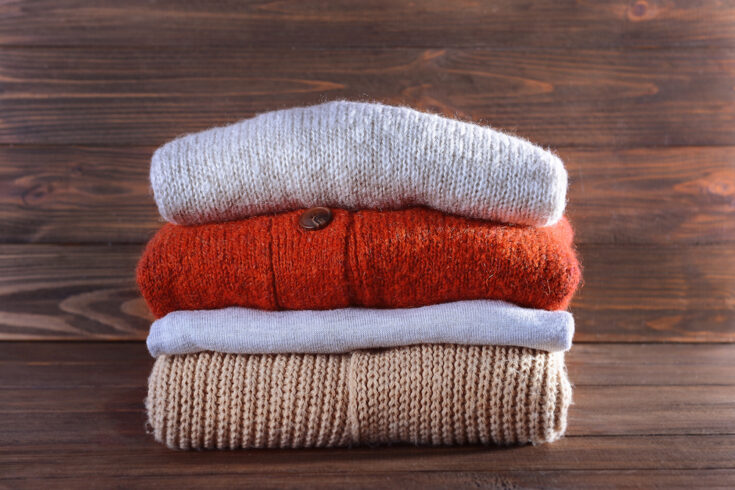If you’re extremely sensitive and struggling with the chemical residues (including light fragrance cross-contamination, sizing chemicals, formaldehyde, chemicals from the dyes, etc) that come on new clothing here are three protocols designed by the most extremely chemically sensitive.
Those who are not very sensitive can use these protocols by adjusting them (as I will note).

1. By “M.R.” a Facebook user, one of the most extremely sensitive (at the time of writing)
She starts with GOTS-certified clothing. She boils them, as per Planet Thrive below, in water with a small amount of sodium carbonate (soda ash). After boiling she washes again in hot water with a dash of soda ash, then rinses in water with a little citric acid. And does a final rinse with lots of water.
This can discolor clothing.
For those less sensitive, you can boil for less time or try this sequence with just hot water (no boiling).
(Also interesting to note: she recommends the following clothing: Cottonique in natural or black, undyed GOTS clothing, organic clothing from Fair Indigo, Pact, American Apparel, and Blue Canoe)
2. From Linda Sepp’s blog
This protocol has been used on cotton, cotton/bamboo blends, cotton/polyester blends, and a few totally synthetic fabrics. It is not safe to use on silk.
Each step is a 24-hour soak of new clothes, towels, or linens in a series of agents below (rinse several times after each soaking):
- Sea salt (or table salt) in filtered water, about 1/4 cup salt to many cups of filtered water, as many as it takes to dissolve all the salt. (Note: Salt can discolor clothing)
- TSP (tri-sodium phosphate). 1/4 cup TSP into very hot water, then add sufficient cold water to bring the mixture to the required temperature for soaking the fabric. This can strip colors from clothes.
- Milk – 1/4 cup skim milk powder into a plastic bin full of cold water. You can use 1/2 cup of milk for this step, but that can reshape clothes. Less than 24 hours for this step.
- White vinegar – 1/2 cup in a bin of cold water.
- Borax and washing soda, or borax and baking soda, plus a bit of powdered oxygen bleach. Mix 1/4 cup borax with hot water to dissolve, then add 1/4 cup washing soda or 1/4 cup baking soda plus 1-2 teaspoons powdered oxygen bleach, and enough water to dissolve all of these ingredients.
- Rubbing Alcohol – If the fabrics still smell, soak them in a very weak solution of rubbing alcohol (99% isopropyl alcohol, 1/4 cup-1/2 cup in a bin of water). Vodka is the alternative.
- Machine wash with the non-toxic laundry detergent of your choice, using vinegar in the fabric softener compartment to neutralize chlorine and to soften. Lemon juice is the alternative to vinegar.
- Boiling clothing can make a huge difference as a last step, once the chemicals have been removed. The water may need to be changed several times.
Those less sensitive can use one or two of these soaks, starting with borax and washing soda, then vinegar, then salt.
See the full protocol here: https://seriouslysensitivetopollution.org/2012/09/08/laundry-decontamination-protocols/
3. Julie from Plant Thrive
Julie’s protocol involves:
- Turning clothes inside out and placing them outside on the clothesline for several days or weeks.
- Boiling clothes for about 5 hours outside with a drop of the laundry detergent she does best with and several handfuls of sea salt (note: salt can discolor clothing).
- Washing the clothes in a washing machine with detergent for a wash cycle with an extra rinse. Washing the clothes again through the wash cycle with the extra rinse, but this time without any detergent.
- Usually, she repeats the whole process, but the subsequent times she would only boil 1-3 hours.
See the full protocol here: https://planetthrive.com/2010/08/washing-clothes/

Melanie
Great list! Formaldehyde tends to be one of the main chemicals I’m sensitive to. I often buy Oeko-Tex which is easy to get a hold of. Kohls Sonoma brand is one we buy often. We could go into the store until they installed the Sephora which stunk up the whole store so we order online now. I’ve seen Oeko-Tex in Walmart and Target as well. But, there are times I have purchased items that aren’t Oeko-Tex and I’ve tried most of these methods. I’ve noticed no diff using vinegar, borax, baking soda methods. I’ve also used a heavier laundry detergent like seventh generation and rewashing with our reg detergent. The boiling method needs done outside. The best I’ve that works is the milk powder. 1 cup in a tub FULL ( this does make a difference) outside for 3-5 hours, stirring every hour to make sure the clothes get submerged. Rinse and spin. Then wash with 1 c of baking soda and 1 c vinegar in fabric dispenser on hottest cycle the clothes can endure. I go ahead and dry but can hang out to dry if you don’t have allergies. Usually, 1 wash is all that is needed for us using this method.
Corinne Segura, Building Biologist
thanks for sharing
Mover Greg
New clothes smell good to me, but thank you for sharing a way to remove that chemical. How harmful can it get to human health?